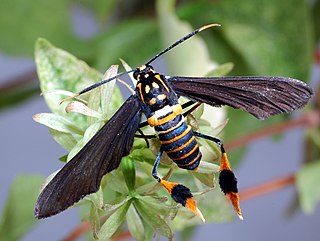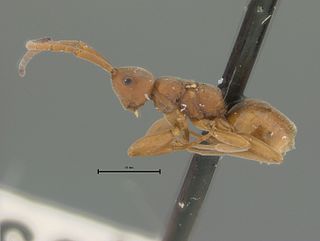Related Research Articles

In evolutionary biology, mimicry is an evolved resemblance between an organism and another object, often an organism of another species. Mimicry may evolve between different species, or between individuals of the same species. Often, mimicry functions to protect a species from predators, making it an antipredator adaptation. Mimicry evolves if a receiver perceives the similarity between a mimic and a model and as a result changes its behaviour in a way that provides a selective advantage to the mimic. The resemblances that evolve in mimicry can be visual, acoustic, chemical, tactile, or electric, or combinations of these sensory modalities. Mimicry may be to the advantage of both organisms that share a resemblance, in which case it is a form of mutualism; or mimicry can be to the detriment of one, making it parasitic or competitive. The evolutionary convergence between groups is driven by the selective action of a signal-receiver or dupe. Birds, for example, use sight to identify palatable insects, whilst avoiding the noxious ones. Over time, palatable insects may evolve to resemble noxious ones, making them mimics and the noxious ones models. In the case of mutualism, sometimes both groups are referred to as "co-mimics". It is often thought that models must be more abundant than mimics, but this is not so. Mimicry may involve numerous species; many harmless species such as hoverflies are Batesian mimics of strongly defended species such as wasps, while many such well-defended species form Mullerian mimicry rings, all resembling each other. Mimicry between prey species and their predators often involves three or more species.

A tarantula hawk is a spider wasp (Pompilidae) that preys on tarantulas. Tarantula hawks belong to any of the many species in the genera Pepsis and Hemipepsis. They are one of the largest parasitoid wasps, using their sting to paralyze their prey before dragging it to a brood nest as living food; a single egg is laid on the prey, hatching to a larva which eats the still-living prey.

Caladenia, commonly known as spider orchids, is a genus of 350 species of plants in the orchid family, Orchidaceae. Spider orchids are terrestrial herbs with a single hairy leaf and a hairy stem. The labellum is fringed or toothed in most species and there are small projections called calli on the labellum. The flowers have adaptations to attract particular species of insects for pollination. The genus is divided into three groups on the basis of flower shape, broadly, spider orchids, zebra orchids and cowslip orchids, although other common names are often used. Although they occur in other countries, most are Australian and 136 species occur in Western Australia, making it the most species-rich orchid genus in that state.

Ant mimicry or myrmecomorphy is mimicry of ants by other organisms. Ants are abundant all over the world, and potential predators that rely on vision to identify their prey, such as birds and wasps, normally avoid them, because they are either unpalatable or aggressive. Spiders are the most common ant mimics. Additionally, some arthropods mimic ants to escape predation, while others mimic ants anatomically and behaviourally to hunt ants in aggressive mimicry. Ant mimicry has existed almost as long as ants themselves, the earliest ant mimics in the fossil record appear in the mid Cretaceous alongside the earliest ants. Indeed one of the earliest, Burmomyra was initially classified as an ant.

Phidippus cardinalis is a species of jumping spider. It is commonly called Cardinal jumper. It is one of the species of jumping spiders which are mimics of mutillid wasps in the genus Dasymutilla ; several species of these wasps are similar in size and coloration, and possess a very painful sting.

Clytus arietis, the wasp beetle, is a wasp-mimicking longhorn beetle species in the genus Clytus.
Pappognatha is a genus of mutillid wasps. Some members of this genus are ant mimics. These wasps occur in Central and South America, and are parasites of orchid bees in the genus Euglossa.

A wasp is any narrow-waisted insect of the order of ants, bees, wasps, and sawflies (Hymenoptera) that is neither a bee nor an ant; some of them can sting their insect prey. The wasp-waisted insects are a complete natural group with a single ancestor; wasps are not such a group, as they do not include the bees and the ants.

Pseudosphex is a genus of tiger moths in the family Erebidae. The genus was erected by Jacob Hübner in 1818. These moths are mimics of a variety of Hymenoptera. The prefix pseudo means "false", and Sphex is a genus of wasps.

Amata huebneri, the wasp moth, is a moth in the genus Amata of the family Erebidae. The species was first described by Jean Baptiste Boisduval in 1829. It is found from the Indo Australian tropics to northern Australia.

Horama panthalon, the Texas wasp moth, is a moth of the subfamily Arctiinae. The species was first described by Johan Christian Fabricius in 1793. It is found in South America, Central America, Mexico, the Antilles and southern United States.

Vespa bicolor, the black shield wasp, described by Johan Christian Fabricius in 1787, is a species of hornet which has been found to be the pollinator of an orchid, Dendrobium sinense, found only on the Chinese island of Hainan. Vespa bicolor also preys on honeybees, which it feeds to its larvae. The orchid produces a chemical that mimics a bee pheromone and attracts this predatory wasp.

In evolutionary biology, mimicry in plants is where a plant organism evolves to resemble another organism physically or chemically, increasing the mimic's Darwinian fitness. Mimicry in plants has been studied far less than mimicry in animals, with fewer documented cases and peer-reviewed studies. However, it may provide protection against herbivory, or may deceptively encourage mutualists, like pollinators, to provide a service without offering a reward in return.

Burmomyrma is an extinct genus of ant-mimic wasp in the extinct family Falsiformicidae. The genus contains a single described species, Burmomyrma rossi. Burmomyrma is known from a single Middle Cretaceous fossil which was found in Asia.
Myrmarachne exasperans is a species of jumping spider found in southeast Asia. The species which was originally described in Java has also been recorded in Borneo, Palawan (Philippines) Vietnam and Bali, where the largest number of individuals have been recorded.

Rhene flavicomans, known as the wasp-mimic jumping spider, is a species of spider in the genus Rhene. It is found in Bhutan, India, Sri Lanka and Thailand.

Pepsis grossa, formerly and perhaps better known as Pepsis formosa, is a very large species of pepsine spider wasp from the southern part of North America, south to northern South America. It preys on tarantula spiders, giving rise to the name tarantula hawk for the wasps in the genus Pepsis and the related Hemipepsis. Only the females hunt, so only they are capable of delivering a sting, which is considered the second most painful of any insect sting; scoring 4.0 on the Schmidt sting pain index compared to the bullet ant's 4.0+. It is the state insect of New Mexico. The colour morphs are the xanthic orange-winged form and the melanic black winged form. In northern South America, a third form, known as "lygamorphic", has a dark base to the wings which have dark amber median patches and a pale tip.
Scaphura is a genus of bush crickets in the sub-family Phaneropterinae. Some of the species within Scaphura are Batesian mimics of wasps, for example the type species, Scaphura nigra, is a polymorphic Batesian mimic of wasps of the genus Pepsis and Entypus (Pompilidae) and the potter wasps Polistes (Vespidae). The genus is restricted to South America.

Embolemidae is a small family of around 20 species and 2 genera distributed around the world. They are small, sometimes very small, solitary wasps. The biology of the Embolemidae is little known, although a Nearctic species, Embolemus confusuus, was reared from the nymph of a planthopper from the family Achilidae where its host fed on fungi beneath the bark of rotting logs. The parasitoid lived in a bulging sac attached to the host nymph between the second and third segments. The females are wingless while the males have wings and in temperate regions emerge later than the females, which overwinter as adults. The wingless females have been recorded from the nests of ants and small mammal burrows, or under stones in pastures and grasslands and they appear to act as ant mimics. The Palearctic species, Embolemus ruddii has been found in association with the ant species Formica fusca and Lasius flavus, while in Japan Embolemus walkeri was taken in a nest of another ant from the genus Myrmica.
Vespamantoida is a genus represented by two species of praying mantises in the family Mantoididae. The genus was erected in 2019 and the name was derived from the Latin word vespa which means wasp and Mmntoida referring to the mantis. These mantis resemble and mimic the behavior of a wasp.
References
| This Cimicomorpha article is a stub. You can help Wikipedia by expanding it. |